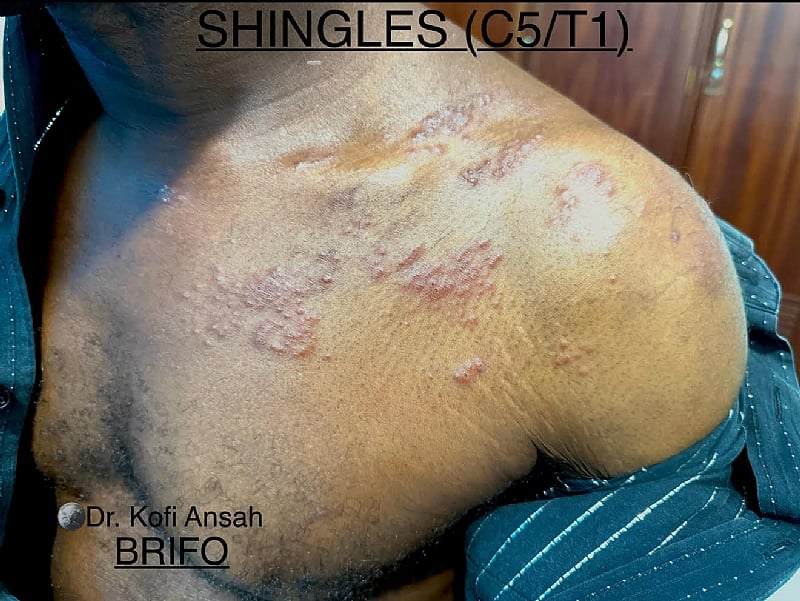Dr. Kofi Ansah Brifo – Resident Dermatologist, Osu Branch, Rabito Clinic – has expressed concern that in many African homes, Grandmother’s intuition still beats Google, and the local herbalist gets more walk-ins than a certified clinic.
He noted that “when a skin rash appears, it is often not seen as a medical issue but a sign — of witchcraft, punishment, or someone working against you from the village.
“From rubbing onions on eczema to bathing in pawpaw leaf water for ringworm, our skin has taken the brunt of cultural improvisation. While some traditional practices stem from a place of love and ancestral wisdom, many have no scientific basis and may even worsen the skin condition.”
Dr Brifo spoke on the topic “Demystifying Skin Diseases: Bridging the Gap Between Cultural Beliefs and Dermatological Science in Sub-Saharan Africa” during the rejuvenated Communication for Development and Advocacy Consult (CDA Consult) weekly health information dissemination platform dubbed “Your Health! Our Collective Responsibility!
The CDA Consult weekly health information dissemination platform is an initiative aimed at promoting health-related communication and providing a platform for health information dissemination to influence personal health choices through improved health literacy.
Dr Brifo noted that “while culture shapes our understanding, science ensures our healing… So let’s bring out the calamine lotion and debunk some myths — one skin condition at a time.
“Shingles (Herpes Zoster) Cultural Belief: If it crosses your waist, you die! Yes, many of us have heard this whispered warning. Auntie Ama sees a blistery rash creeping across your back and immediately advises a chalk line and fasting.
“Scientific Truth: Shingles isn’t a spiritual attack. It’s a reactivation of the chickenpox virus (Varicella-Zoster Virus) that has stayed dormant in your body since childhood. Think of it as an uninvited guest popping back in — often triggered by stress, old age, or a weakened immune system.
“It doesn’t cross your waist and transport you to the ancestral plane. What it does do is cause painful, burning blisters, usually along one side of the body, in a stripe or belt-like pattern. It can affect the face, back, or chest — and yes, even the waist.”
Dr Brifo explained that it is a tingling or burning sensation, fluid-filled blisters in a line or band, redness, and pain, and sometimes associated with fever.
The Resident Dermatologist, Osu Branch, Rabito Clinic, also expressed concern about the application of some popular traditional remedies, which include smearing charcoal paste, applying “fufu water”, using chicken feathers or eggs, and drawing a chalk line across the rash.
He disproved these traditional remedies and offered the medically proven approach, which includes starting with antiviral treatment (like acyclovir or valacyclovir) early — within 72 hours.
He said, “This reduces pain, shortens the illness, and prevents complications like post-herpetic neuralgia – persistent pain after the rash is gone. No need for chalk, feathers, or midnight rituals — just see a doctor early.”
The Resident Dermatologist, Osu Branch, Rabito Clinic, noted that in Ghana, skin diseases are among the top ten causes of outpatient visits — yet often the last to be taken seriously, stressing that “the stigma associated with visible skin lesions leads people to delay seeking help, fearing gossip or spiritual labeling.
“Shingles, for instance, is commonly misdiagnosed as witchcraft, spiritual attack, or poison, leading many to herbal centers rather than health centers.”
He noted that delays in visiting the health facility can cause serious complications, including chronic nerve pain, eye damage (if the face is involved), and secondary bacterial infections.
Dr Brifo noted, however, that early diagnosis and treatment from a licensed medical practitioner — especially a dermatologist — “can prevent these outcomes.”
On Bridging the Cultural Gap, the Resident Dermatologist, Osu Branch, Rabito Clinic, while acknowledging that traditions are part of our heritage, believes “it’s time to bring tradition and science into respectful dialogue.
“Imagine a world where Grandmother would say, Let us pray about the ailment, and after the prayers, let us go to the dermatologist. Now that’s a powerful combination.”
Dr Brifo advises, “If you or a loved one develops a painful blistering rash on one side of the body, especially if preceded by burning or tingling, don’t wait, stressing, “Go to a clinic or hospital within 48–72 hours.”
He recommended that the patient avoid bursting the blisters or applying raw substances while encouraging the patient to practice good hygiene, wear loose clothing, and take medically recommended painkillers and antivirals, which can make a huge difference.
“And if it does cross the waist, don’t panic; just cross over to the nearest qualified health professional,” he advised.
Dr Brifo noted: “Skin is not just the body’s covering; it’s a window into our health, our confidence, and often, our culture. As we strive to modernize healthcare in Africa, let’s also modernize our mindset.
“Your skin is not a spiritual bulletin board. It’s a living organ deserving of respect, science-based care, and, yes, some cultural understanding.”
Mr Francis Ameyibor, CDA Consult Executive Director, explained that CDA Consult developed the public health advocacy platform “Your Health! Our Collective Responsibility” to investigate the components of four health communication approaches: informing, instructing, convincing, and promoting.
The CDA Consult Executive Director stressed that it forms part of the general health advocacy project Holistic Health Information Change Paradigm Advocacy to educate the public on health issues to complement the efforts of health personnel and also make sure that the public receives healthy information from qualified personnel.



